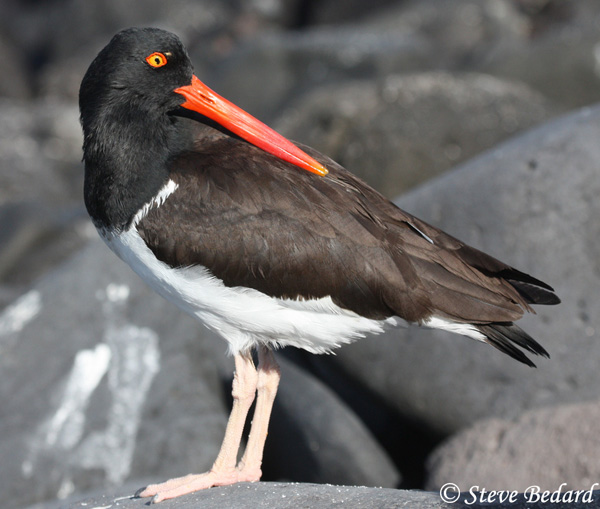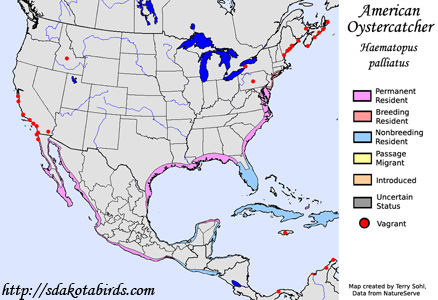| Length: 18 inches | Wingspan: 32 inches | Seasonality: Non-resident in South Dakota |
| ID Keys: Long orange bill, dark upperparts, white underparts, pale legs, orange eye-ring | ||
 The
American Osytercatcher is a distinctive, large shorebird found on the
Atlantic and Gulf coasts of the United States. Their range also
includes the Pacific coast of Mexico, and both coasts of South America.
They are similar in structure and general appearance to the
Black Oystercatcher, but the
ranges of the two species do not overlap, and each are found in different
habitats. The American Oystercatcher is found on open beaches and
mudflats, while the Black Oystercather is found on rocky shorelines.
The
American Osytercatcher is a distinctive, large shorebird found on the
Atlantic and Gulf coasts of the United States. Their range also
includes the Pacific coast of Mexico, and both coasts of South America.
They are similar in structure and general appearance to the
Black Oystercatcher, but the
ranges of the two species do not overlap, and each are found in different
habitats. The American Oystercatcher is found on open beaches and
mudflats, while the Black Oystercather is found on rocky shorelines.
Habitat: Found exclusively in coastal zones with large expanses of sand beach or mudflats.
Diet: Primarily feeds on shellfish, but will also feed on a variety of other coastal animals such as jellyfish, marine worms, crabs, and sea urchins.
Behavior: Forages by walking on the shore or in shallow water, locating food by sight. When finding a shellfish, the Oystercatcher will either directly smash the shell to retrieve the inner contents, or will directly access the meat if a shellfish is partially open. They will also sometimes probe in the mud or sand with their bills to feed on marine worms and other creatures.
Nesting: The nest of an American Oystercatcher is a shallow depression in the sand, lined with small rocks and shells. Both the male and female help to incubate the eggs. Upon hatching, the young leave the nest, where they are tended to and fed by both parents.
Interactive eBird Map: Click to access an interactive eBird map of American Oystercatcher sightings
Song: The American Oystercatcher has various calls including a loud single-syllable yip, and a series of whistled alarm calls.
Migration: Many American Osytercatchers are permanent residents. However, other birds obviously are migratory, as there are winter populations in parts of the Caribbean and Central America that are absent during the summer months.
Similar Species: Black Oystercatcher has the same overall structure, but white underside on American Oystercatcher makes differentiating the two species quite easy (as well as the fact that the ranges of the two species don't come close to overlapping). American Oystercatchers are quite similar in overall appearance to the Eurasian Oystercatcher. However, that species is only an extremely rare visitor to North America.
Conservation Status: Populations crashed by 1900 due to hunting and habitat loss. Since then, numbers have rebounded, and the species seems to have adapted fairly well to a human presence in and around coastal zones. The IUCN lists the American Oystercatcher as a species of "Least Concern".
Further Information: 1) Texas Wildlife - American Oystercatcher
2) Cornell's All About Birds - American Oystercatcher
3) South Carolina DNR - American Oystercatcher
Photo Information: Photo taken by Steven Bedard - Licensed under Creative Commons Attribution 2.0 Generic License.
| Click below for a higher-resolution map |
 |
| South Dakota Status: Non-resident in South Dakota |
Additional American Oystercatcher Photos (coming soon!)
